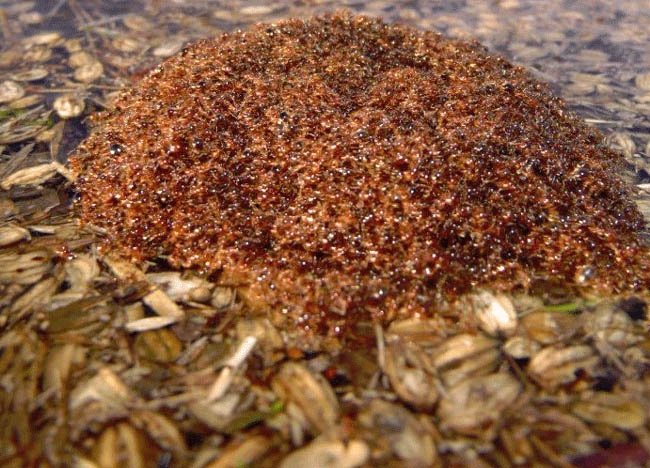April 1, 2013

Amid all this heavy spring rainfall, fish pond owners not only should be mindful of flooding but also of the great balls of fire that often accompany flooded ponds.
While these fireballs are no harbinger of doom, they can bring painful stings and, based on some evidence, possibly fish kills.
At closer inspection, these balls are actually large masses of imported fire ants.
Nature has equipped these fire ants with an unusual skill. During periods of severe flooding, these ants, fleeing washed out colonies, form themselves into huge balls — rafts, as insect experts describe them — in an attempt an escape to drier ground.
These rafts are held together by a collective effort, with all the worker ants joining hands, or tarsi, as insect hands are called, according to an online extension publication by Linda-Hooper Bui, a fire-ant expert and associate professor of entomology at Louisiana State University.
The highly adaptive workers constantly move around these rafts, assuring that individual ants are not submerged in water for long.
The ants carry the eggs and tiniest larvae in their mouths. Older larvae and pupae are kept at the bottom of the raft, helping the structure stay afloat.
Winged males aren’t so lucky: They are the first to be jettisoned.
For his part, Russell Wright, an Alabama Cooperative Extension System fisheries specialist and Auburn University associate professor in the Department of Fisheries and Allied Aquaculture, expresses amazement at the adaptive traits these ants have demonstrated around fish ponds.
“They seem to be very well adapted to fluctuating water levels in soils,” Wright says. “We even noticed that the ants will use the dense vegetation to move right across the surface of some ponds to forage for insects.”
In cases of pond flooding, Wright says the ant rafts will float out into the pond in search of dry land, with the ants crawling onto protruding sticks and other surface material in search of safe havens. Some of them eventually make it back to shore.
Headaches for pond owners
While the whole spectacle is fascinating to watch, these ant rafts can cause major headaches for pond owners and often do, Wright says.
“From a pond-management perspective, this can be bad news, because these large collections of ants provide optimal feeding opportunities for fish, particularly bluegills,” he says.
Wright and other fisheries experts have long suspected that consuming too many of these ants can be lethal.
In fact, Wright says he can just about expect a call from one or more concerned pond owner during extended periods of heavy rainfall.
The most susceptible fish appear to be the bluegill, the South’s primary forage and sports fish species.
“I’ve cut up dead bluegills and found live ants still in their stomachs,” Wright says.
There is still some debate among entomologists over whether fish kills actually are caused from eating too many of the ants.
As the ants provide fish with a potentially abundant food supply, entomologists have speculated that consuming large quantities of these ants, coupled with the venom from their stings, may cause fish kills.
Based on his own experience and discussing the matter with other fisheries experts, Wright suspects some connection.
“While there hasn’t been a lot of research into this issue, we’re reasonably sure it’s from consuming large numbers of these ants, because there doesn’t appear anything else wrong with them.”
Wright has noticed similar fish kills in April and May, when many fire ant reproductives emerge from mounds and begin swarming. Many of these end up on pond surfaces where they are consumed by fish.
“When I get a call from a pond owner in April or May expressing concern about fish mortalities, I’m reasonably sure it’s from fire-ant exposure after I’ve eliminated some of the other possible causes,” he says.
Pond managers aren’t the only ones affected by these ant rafts.
First responders into flooded areas have occasionally been treated for multiple fire-ant stings.
“It’s ironic in a way because as relief workers are wading around in this water, they’re thinking about a host of other things, such as water contamination,” Wright says. “They seldom think about brushing up against these balls of ants searching for a safe haven.”
“Once these ants realize they’re on an animal rather than dry land, they start stinging, and for people who are sensitive to their stings, this can be a real problem.”
Special care should be taken in treating fire ants around ponds, says Kathy Flanders, an Alabama Cooperative Extension System entomologist and Auburn University professor of entomology and plant pathology.
The best alternatives are fire-ant bait products, which contain small amounts of active ingredients. These can be applied near shorelines but not directly to the water. Every effort should be made to avoid contaminating the water with pesticides.
The most optimal time to apply baits is while the ants are foraging, Flanders says. However, these should not be applied if rain is in the immediate forecast. The best time to apply fire-ant baits is between April and October.
You May Also Like




